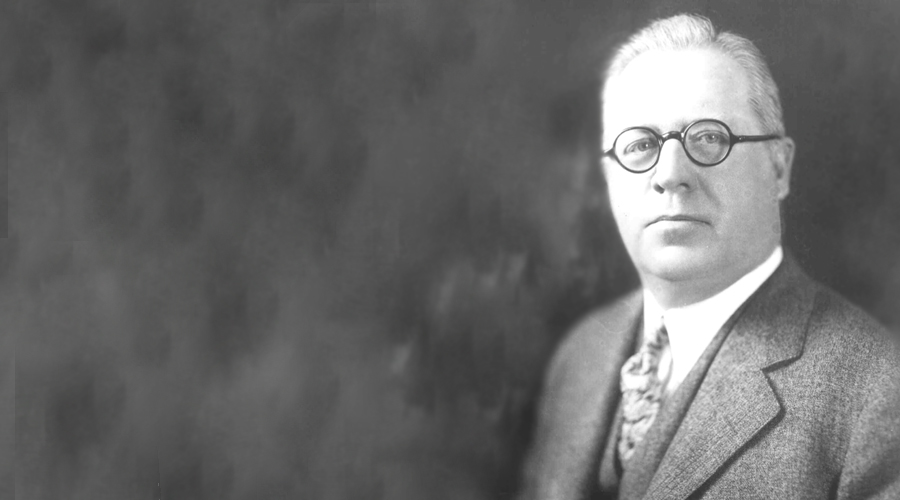

Honest H.V. Foster
Written by: Anlan Cheney
Henry Vernon Foster represented many things to many people, his family and closest friends included.
Most who know of H.V. Foster know him by the surface success: a shrewd oilman who became a Bartlesville beneficiary and who helped put the region on the map. Yet, the real Foster was much more than a standout industry baron. He was a multifaceted man of strong principles, quiet generosity, devotion to his family, and a love of the outdoors.
EARLY LIFE
Foster acquired the family oil business after the death of his uncle in 1902, his father having died some years earlier. The then 27-year-old Foster rescued the debt-ridden Phoenix Oil Company by brilliantly breaking up and negotiating land lease renewals on his land in Osage Indian Territory. By developing the Osage land and later the Seminole and Oklahoma City fields, Foster established himself as a significant player in the oil industry.
This unprecedented success prompted the Kansas City Star to dub him the “richest man west of the Mississippi,” and perhaps few realized how far such a title would overshadow Foster’s true legacy.
Foster, whose Quaker heritage influenced him for the rest of his life, was said to be a kind, generous, and compassionate man, even while being prone to impatience and a quick temper. “He was a man of few words and a strong disciplinarian, and he commanded respect and loyalty from those he worked with and who worked for him,” wrote his granddaughter Ami Preston.
Foster had married his wife Marie Dahlgren, a former vaudeville dancer and singer in Chicago, in 1907 after spotting her while she performed on Broadway. According to the family story, Foster followed her performance company, Keith Productions, from city to city and even as far as Mexico until he persuaded her to marry. They had two daughters, Ruth and Marie.
In his relationships, Preston observed that, “He was tough beneath a soft-appearing countenance with business associates, and soft behind a stern-appearing countenance to his family.” Foster commissioned the well-known La Quinta Mansion in the Spanish style, among other reasons, in order to please his daughters who had a great interest in the architecture of Mexico and Spain.
PASTIMES
He enjoyed the outdoors immensely, and spent a great deal of time fishing and hunting at his family’s ranch house near Bartlesville, Rancha de la Codorniz. He was an active member of the Lotus social club in New York City, which was a group of notable men of his time who periodically met for dinner and an address given by significant authors, scientists, statesmen, politicians, and other various industry leaders. His interest in these activities reflects his commitment to an ongoing education.
Indeed, Foster enabled two hundred fifty young people to attend college with his financial help, each of which was sworn to secrecy. For one of these young people in particular, V. Robert Kerr, Foster’s help was the difference that enabled him to earn an engineering degree from the Colorado University at Boulder. Kerr later established the H. V. Foster Memorial Scholarship at CU. “He helped me through, and so I feel that I owe help to somebody else, with the idea of repaying Mr. Foster for what he did for me,” Kerr told the Bartlesville Examiner-Enterprise, alluding to the desire Foster had that his beneficiaries pay it forward, not back.
Foster and his wife also gave freely – albeit quietly – to numerous philanthropic and charitable initiatives. Foster was said to have personally put together food baskets during the holidays and deliver them without knocking or without notes so as not to tout his own generosity. When the Fosters began building their two houses – the La Quinta Mansion and Rancha de la Cordoniz – in 1929 after the market crash, the couple made it a point to hire many men with families so as to enable them to provide for their own.
LEGACY
Foster’s modesty and strong character set him apart from others, both in business dealings and in his private life. He left his name on his oil company only, and requests made to honor his name after his death were often turned down, his wife and daughters replying, “Daddy didn’t want that.” According to Preston, “He disliked publicity and detested social pretenses, and, in spite of the fact that he had an amazing career, didn’t seem to be puffed up with his own importance.”
His true portrait was most accurately painted in a 1930 Kansas City Star report when it stated that, “[Foster] had one trait of character that saved him many a time from utter financial ruin; his native honesty. These things were said about young Foster by those clearly associated with him: ‘He never breaks his word. You don’t need a contract with him. If he says he’ll do a thing, you can take it to the bank.’”
On her great grandfather, Darian Doornbos-Kedy said, “I believe that H.V. Foster was probably the best-kept secret in the oil industry. I think there are a lot of people who don’t know anything about him and that’s okay–because I think he really would have wanted it that way.”
So perhaps the “richest man west of the Mississippi” ought to be better known as the oil industry’s “best kept secret,” the quiet and modest man whose unassuming legacy carries on in the spirit of a strong, generous, and principled man outside of the spotlight.